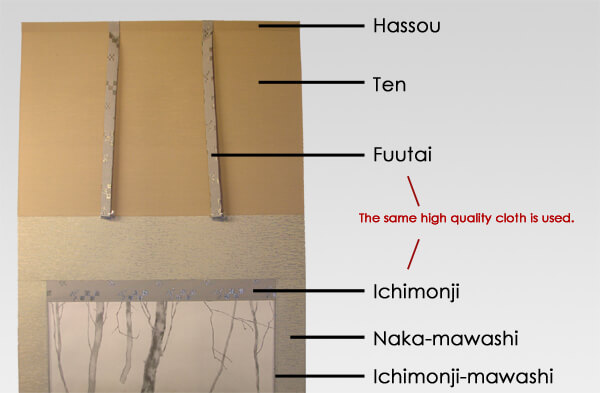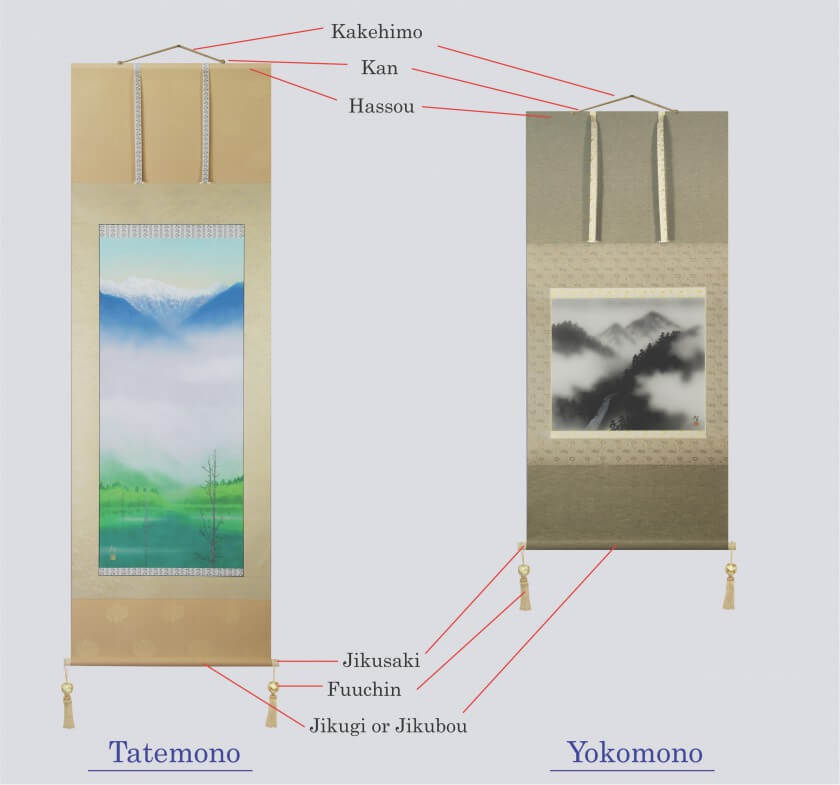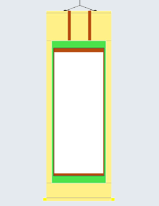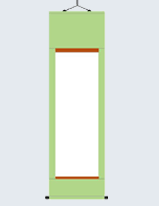Lesson
News / Blog
Other Menus
Previous Knowledge
Fuutai
“Fuutai” is a term used for one of the parts of the kakejiku. Fuutai usually consists of two long narrow strips of cloth sewn to “hassou” (the upper crosspiece). Their lengths match the height of the upper portion of the mounting, “ten”(top). By their positioning, they divide ten vertically into three equal sections. Formal fuutai are called “sage-fuutai” or “ichimonji-fuutai,” because the same high quality cloth is used for both fuutai and “ichimonji” (two brocade borders). Attached to the right and left sides of the lower end of each fuutai are cotton or silk threads in the form of small tassels or tufts called “tsuyu” (dew). They are attached from 4.5 mm to 6 mm above the lower edge of fuutai and extend to below the edge.
Mawashi
An enclosure that surrounds the work with the same cloth is called “mawashi.” An enclosure that surrounds something with thin, line-like cloth is called “suji-mawashi.” An inside mawashi is called “naka-mawashi” or “chuu-mawashi,” and an outside “mawashi” is called “soto-mawashi.”
There is a section of ichimonji (two brocade borders) made from “kinran” (gold thread). The upper side of ichimonji is called “kami-ichimonji,” and the underside of ichimonji is called “shimo-ichimonji.” An enclosure that surrounds the work with the same cloth as ichimonji is called “ichimonji-mawashi.”


Others
If the width of a work is shorter than the height, the work is called a “tatemono” (vertical work). If the width is longer than the height, the work is called a “yokomono” (horizontal work).
“Ten” (top) is longer than “chi”(bottom) because in the past, a “kakejiku” (hanging scroll) was viewed from a kneeling position which provided perspective on “honshi” (main work). This tradition carries on to modern times.
There is a cylindrical rod called “jikugi” at the bottom, which becomes the axis or center of the scroll, when it is rolled up. The end knobs on this rod are called “jikusaki” and are used as handles when rolling and unrolling the scroll.
The semi-circular wooden rod at the end of the scroll is named “hassou” and is used when rolling and unrolling the scroll. Metal loops (“kan”) are attached to the hassou in order to attach the “kakehimo” or “kakeo” (hanging thread) used to hang the scroll. “Makihimo” or “makio” (wrapping cord), which is used to tie a kakejiku that has been rolled, is attached to the kakehimo. Jikusaki can be made of plastic, ceramic, lacquered wood, rosewood, artificial ivory, and so on.
“Fuuchin” is a weight put on the tip of a roller of a kakejiku. Fuuchin is a decorative wood or ceramic piece used for preventing a kakejiku from swinging in the wind.

Contents Link
 Previous Knowleadge Previous Knowleadge |
 Yamato-style Mounting Yamato-style Mounting |
 Literati Mounting Literati Mounting |

